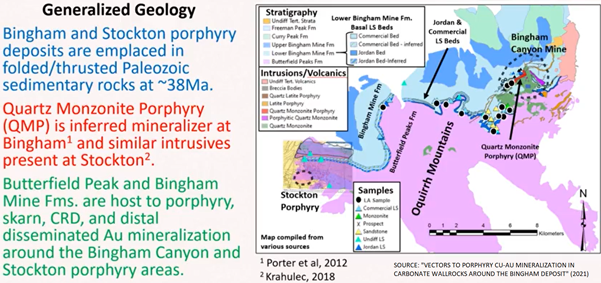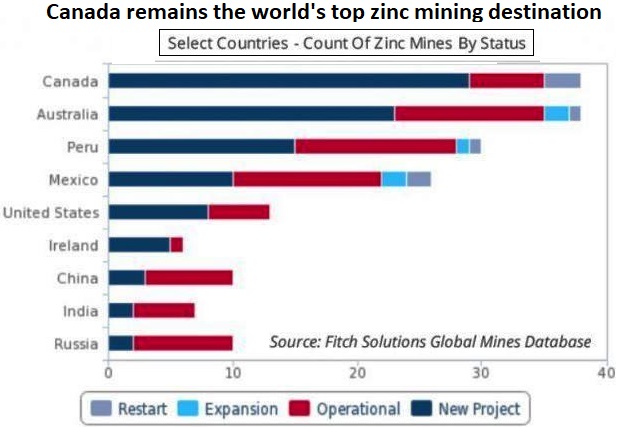Disseminated on behalf of Core Assets Corp. and Zimtu Capital Corp.
Today, Core Assets Corp. announced assay results from the remaining holes completed during the maiden 2022 drilling program at the Silver Lime Porphyry-CRD Project and the Laverdiere Skarn-Porphyry Project at the Blue Property located in the Atlin Mining District of NW British Columbia, Canada.
At and near surface, CRDs are typically thin pipe-like bodies of high-grade mineralization, running continuously all the way to the source, thereby thickening substantially at depth and the closer you get to the feeding intrusion. As such, this first round of drilling was a highly successful “scout/pathfinder“ program, with the goal of confirming grades below surface and to get a first picture of how the plumbing and feeder systems run, in order for follow-up drilling to target thicker packages of mineralization delineated based on geologic information gathered from the first round of drilling.
What strikes the eye are the impressive grades of molybdenum increasing at depth at the Sulphide City Porphyry-Skarn Target, and the fact that copper begins to pick up hosted in chalcopyrite with phyillic alteration present. This indicates a large copper-moly porphyry with high-grade skarn mineralization near surface and possibly at depth. Molybdenum prices have appreciated 6-fold over the last 7 years, doubling from $37 to $74 USD per kilogram in the last 7 months.
Rio Tinto‘s Bingham Canyon Porphyry Deposit in Utah, in production since 120 years, hosts 2021-reserves totalling 541 million t with an average grade of 0.44% copper, 0.17 g/t gold, 2.22 g/t silver, and 0.029% molybdenum. Compare these first-class grades with the initial drill results from Sulphide City and you may come to the conclusion that Core Assets has confirmed today to have tapped into something special. This might be just the beginning of an incremental success story, especially when considering that Core Assets still has all of its widespread CRD system untouched, whereas Bingham‘s near-surface CRDs were mined long before Rio Tinto started mining the near-by porphyry in 1903.
Source: https://youtu.be/Hbrc5dF0SiM
Core Assets‘ news-release today:
Core Assets Drills 5.64m of 254g/t Ag, 9.9% Pb+Zn, 0.11% Cu and 0.12g/t Au Including 424g/t Ag, 17.4% Pb+Zn, 0.20% Cu, and 0.14g/t Au Over 3.15m at the Blue Property
To view a video presentation based on today’s news release by CEO Nick Rodway, Click HERE
Source: https://youtu.be/bCDOrTNa72k
Vancouver March 29, 2023 – Core Assets Corp., (“Core Assets” or the “Company”) (CSE:CC) (FSE:5RJ) (OTC.QB:CCOOF) is pleased to announce assay results from the remaining diamond drill holes completed during the 2022 exploration program at the Silver Lime Porphyry-CRD Project (the “Silver Lime Project” or “Silver Lime”) and the Laverdiere Skarn-Porphyry Project (the “Laverdiere Project” or “Laverdiere”) at the Blue Property (the “Blue Property”) located in the Atlin Mining District of NW British Columbia.
A total of 1,497 metres of diamond drilling were completed at the Grizzly CRD Target in 2022. First-pass diamond drilling at the Grizzly Target intersected significant near surface, high-grade carbonate replacement mineralization (Figures 1-2; Tables 1, 3).
Grizzly CRD Target Highlights
• SLM22-011 intersected 5.64m of 659g/t AgEq (254g/t Ag, 5.1% Pb, 4.8% Zn, 0.11% Cu and 0.12g/t Au) from 57.36m core depth including 3.15m of 1,132g/t AgEq (424g/t Ag, 9.1% Pb, 8.3% Zn, 0.20% Cu, and 0.14g/t Au), and extending the previously rushed carbonate replacement massive sulphide intercept which included 1.16m of 3,056g/t AgEq (1,145g/t Ag, 23.2% Pb, 23.5% Zn, 0.52% Cu, and 0.37g/t Ag) from 58.54m depth.
• SLM22-010 intersected 2m of 218g/t AgEq (99g/t Ag, 0.4% Pb, 1.8% Zn, and 0.5% Cu) from 276m depth, including 0.90m of 287g/t AgEq (141g/t Ag, 0.5% Pb, 2.5% Zn, and 0.14% Cu).
• SLM22-009 intersected 2.23m of 124g/t AgEq (63g/t Ag, 0.6% Pb, and 0.9% Zn) from 143m depth, including 0.73m of 375g/t AgEq (192g/t Ag, 1.9% Pb, and 2.6% Zn).
• All drill intercepts remain open in multiple directions and at depth (down-dip).
Core Assets’ President & CEO Nick Rodway commented: “The first ever drill season at the Silver Lime and Laverdiere projects have yielded remarkable results – confirming the presence of large, well-mineralized porphyry-skarn and CRD systems. Data collected in 2022 will allow us to execute a targeted, fully funded-CRD focused drilling program which will begin in the next few months. As we begin to demonstrate continuity in our new discoveries, we plan to step out into thicker limestone sequences to the northwest of Silver Lime and test the additional >250 CRD occurrences that have been mapped at surface. We are confident that the 2023 exploration season will be transformational for the company and its shareholders.”

Full size / Assay results are presented as uncut weighted averages and assume 100% metal recovery. Interval widths represent drilled HQ core lengths and true width is unknown currently. * indicates partial drill hole assay results were previously released. Silver equivalent (AgEq) grades are calculated using metal prices of silver US$21.25/oz., gold US$1,850/oz, copper US$4.00/lb, lead US$1.00/lb and zinc US$1.40/lb. Silver equivalent grade is calculated as AgEq (g/t) = Ag (g/t) + (Cu (%) * 129.08) + (Pb (%) * 32.27) + (Zn (%) * 45.18) + (Au (g/t) * 87.06).

Full size / Figure 1: Schematic cross-section looking north through the Grizzly CRD Target at the Silver Lime Project showing 2022 drilling assay highlights intercepts (AgEq) in relation to the inferred depth extent of mineralization targeted during the 2022 drilling program.
A total of 2,769 metres of diamond drilling were completed at the Sulphide City Porphyry-Skarn Target in 2022. First-pass diamond drilling intersected widespread and consistent porphyry Molybdenum (Mo) mineralization, local high grade porphyry Mo veining, and massive sulphide Zn-rich skarn mineralization.
Sulphide City Porphyry-Skarn Target Highlights
• SLM22-005 intersected 4.51m of 172g/t AgEq (50g/t Ag, 2.5% Zn, 0.3% Pb, and 0.1% Cu) from 32.70m depth, including 0.56m of 709g/t AgEq (148g/t Ag, 12.1% Zn, 0.4%, and 0.2% Cu).
• SLM22-006 returned 99.82m of 0.016% Mo from 322m depth, including 10.82m of 0.043% Mo and 0.63m of 0.385% Mo.
• SLM22-007 intersected 1.26m of 389g/t AgEq and 3.06% CuEq (91g/t Ag, 1.5% Zn, 1.5% Pb, and 1.4% Cu) from 56.91m depth, and 1.17m of 11.3% Zn, 9g/t Ag, and 0.1% Cu from 96.15m depth.
• SLM22-008 intersected 1m of 4.23% Zn, 7g/t Ag, and 0.2% Cu from 219.6m depth.
• SLM22-013 returned 0.53m of 9% Zn from 242.78m depth.
• SLM22-014 intersected 14.53m of 0.029% Mo from 266m depth, within 101.38m grading 0.013% Mo and including 2m of 0.137% Mo from 277m depth.
• SLM22-015 returned 147.45m of 0.012% Mo from 190.05m depth, within 350m grading 0.008% Mo and including 2m of 0.075% Mo from 216m depth.

Full size / Figure 2: Schematic plan view map of the Grizzly and Sulphide City targets at the Silver Lime Project showing 2022 drilling locations, Ag (g/t) in surface samples, downhole Mo % (Sulphide City) and Ag g/t (Grizzly – Red Star) assay highlights. *indicates steeply dipping drillhole.

Full size / Assay results are presented as uncut weighted averages and assume 100% metal recovery. Interval widths represent drilled HQ core lengths and true width is unknown currently. * indicates partial drill hole assay results were previously released. Silver equivalent (AgEq) and Copper equivalent (CuEq) grades are calculated using metal prices of silver US$21.25/oz., gold US$1,850/oz, copper US$4.00/lb, lead US$1.00/lb, molybdenum at US$30.00/lb, and zinc US$1.40/lb. Silver equivalent grade is calculated as AgEq (g/t) = Ag (g/t) + (Cu (%) * 129.08) + (Pb (%) * 32.27) + (Zn (%) * 45.18) + (Au (g/t) * 87.06). Copper equivalent grade is calculated as CuEq (%) = Cu (%) + Ag*0.0077) + (Pb (%) * 0.25) + (Zn (%) * 0.35) + (Au (g/t) * 0.674 + (Mo (%) * 7.5).
A total of 1,806 metres of diamond drilling were completed at the Laverdiere Skarn-Porphyry Project in 2022. First-pass diamond drilling intersected significant near surface, high-grade Fe-Cu-Au-Mo skarn mineralization associated with a potassically altered porphyry intrusion containing widespread porphyry Cu-Mo-Au mineralization and veining (Figure 3; Tables 4-5).
Laverdiere Skarn-Porphyry Project Highlights
• LAV22-001 intersected 48.54m of 1.02% CuEq (0.90% Cu, 6g/t Ag, and 0.11g/t Ag) from 31.46m, including 0.60m of 5.51% CuEq (5% Cu, 33g/t Ag, and 0.36 g/t Au) from 42.15m depth.
• LAV22-001 also intersected 1.51m of 4.59g/t Au from 163.49m depth in the Llewellyn Fault Zone (LFZ)
• LAV22-002 returned 223m of 0.20% CuEq (0.11% Cu, 2g/t Ag, and 0.006% Mo) from 15.00m depth, including 79m of 0.26% CuEq, and 24.42m of 0.50% CuEq.
• LAV22-003 returned 30.49m of 0.22% CuEq (0.12% Cu, 2g/t Ag, 0.03 g/t Au, and 009% Mo) from 4.51m depth.
• LAV22-004 intersected 7.66m of 0.24% Cu, 0.014% Mo, 3.4g/t Ag, and 0.07g/t Au from 222m depth, including 2.46m of 0.37% Cu, 0.022% Mo, 6.6g/t Ag, and 0.21g/t Au from 227.2m depth.
• LAV22-005 returned 83.22m of 0.016% Mo, 0.12% Cu, 0.8g/t Ag, and 0.03g/t Au (0.27% CuEq) including 31.08m of 0.042% Mo, and 6.2m of 0.105% Mo from 6.9m depth.
• LAV22-006 intersected 348.65m of 0.010 % Mo from 3.35m depth, including 183m of 0.018% Mo, 11m of 0.092% Mo (0.13% Cu, 5g/t Ag (0.84% CuEq), and 5.5m of 0.11% Mo.
• LAV22-006 also returned 107.38m of 0.31 CuEq (0.11% Cu, 0.023% Mo, 0.9g/t Au, and 0.02g/t Au) from 144.62m depth, including 41m of 0.60% CuEq (0.27% Cu, 0.037% Mo, 2g/t Ag, and 0.05g/t Au), and 0.9m of 6.09% CuEq (5.08% Cu, 23g/t Ag, 1.25g/t Au) from 166.64m depth.

Full size / Assay results are presented as uncut weighted averages and assume 100% metal recovery. Interval widths represent drilled HQ core lengths and true width is unknown currently. * indicates drill hole assay results were previously released. Copper equivalent (CuEq) grades are calculated using metal prices of silver US$21.25/oz., gold US$1,850/oz, copper US$4.00/lb, and molybdenum at US$30.00/lb. Copper equivalent grade is calculated as CuEq (%) = Cu (%) + Ag*0.0077) + (Pb (%) * 0.25) + (Zn (%) * 0.35) + (Au (g/t) * 0.674 + (Mo (%) * 7.5).
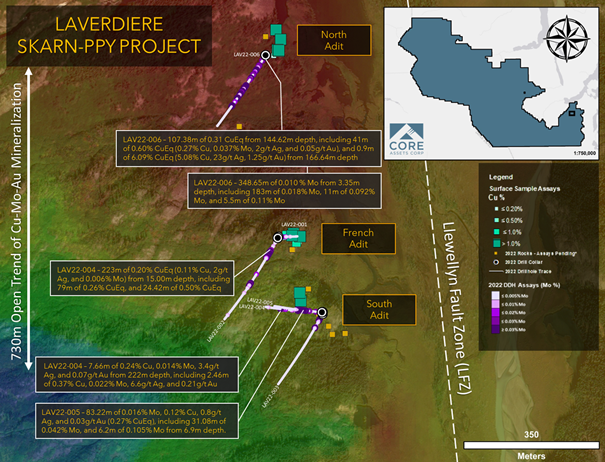
Full size / Figure 3: Schematic plan view map of the Laverdiere Skarn-Porphyry Project showing 2022 drilling locations, Cu (%) surficial sampling progress, and downhole Mo (%) assay highlights. Map elements plotted on TauSf resistivity map (Resistive = cold colours, Conductive = hot colours). The blue-green resistive zone correlates with the mapped location of the Laverdiere Mo-Cu±Au Porphyry.
Sampling Protocol, Quality Assurance & Quality Control
All recovered drill core was transported by helicopter to the core logging facility in Atlin, British Columbia for processing. Down hole surveys were conducted on all drill holes upon termination, using a Reflex Gyro Sprint downhole survey tool equipped with an azimuth positioning capability. Drill core was typically sampled over two-meter intervals and occasionally reduced in areas of higher visual sulphide mineralization. Core samples were cut in half with an electric core saw, bagged, labelled, sealed, and submitted to ALS Minerals preparation facility in Whitehorse, YT with the remaining core stored in Atlin, BC. Half core samples were finely crushed and sieved to
About the Silver Lime Porphyry-CRD Project
5,565 metres of exploratory HQ-sized diamond drilling has been completed at the Silver Lime Porphyry-Skarn Project. 2022 drilling successfully confirmed the presence of high-grade carbonate replacement mineralization at depth, as well as widespread porphyry Mo mineralization and associated mineralized skarn. All surficial mineralized structures targeted during the 2022 drilling campaign are confirmed at depth.
The Silver Lime Project is predominantly hosted in carbonate rocks of the Florence Range Metamorphic Suite (ca. 1150Ma). Target limestone and marble host rocks are intercalated with upper amphibolite grade metapeltic rocks, quartzite, and amphibole-bearing gneiss. The protoliths to the metasedimentary units include continentally derived clastic strata and platform carbonate, whereas the amphibole-bearing gneiss is interpreted as probable basaltic flows, sills, dykes, and tuffaceous units related to early rifting of the ancestral North America continental margin (i.e., Mihalynuk, 1999). Younger felsic to intermediate intrusive rocks are also widespread within the project area and range from Triassic to Eocene in age. Widespread Eocene magmatic activity was associated with Cordillera-wide, brittle strike-slip faulting. Eocene volcano-plutonic centres in the western Cordillera are known to host porphyry, skarn, and epithermal-type mineralization extending from the Golden Triangle in NW British Columbia to the Tally-Ho Shear Zone in the Yukon (>100 kilometers).
Three well-defined target areas exist at the Silver Lime Project and include the Jackie, Sulphide City, and Grizzly targets. The Jackie Target represents a dyke proximal expression of Ag-Pb-Zn-Cu CRM that consists of numerous massive-to-semi massive sulphide occurrences measuring up to 30 metres long and 6 metres wide and comprise an approximate area of 400 metres by 380 metres. Many sulphide occurrences at Jackie are clustered and hosted within NE-SW trending faults and fault splays, proximal to undeformed felsic dykes oriented sub-parallel to faulting. These fault-hosted sulphide bodies are interpreted as “spokes” that typically broaden at depth and express continuity back towards a causative intrusion. The Sulphide City Porphyry-Skarn Target is characterized by multiple semi-massive to massive sulphide occurrences measuring up to 40 metres along strike and 8 metres wide. In 2022, detailed geological mapping and diamond drilling discovered a Mo-Cu-bearing and causative porphyry intrusion. The Sulphide City Target boasts an average surficial grade of 13.3g/t Ag, 0.34% Cu, and 3.9% Zn (83 rock samples) that remains open. The Grizzly Ag-Zn-Pb-Cu-Au CRD Target represents the largest, untested surficial exposure of CRM globally. Carbonate replacement manto, chimney, and dyke-contact skarn mineralization at Grizzly are observable at surface across open strike lengths of up to 1 kilometer, and at widths of over 5 meters. Average surficial grade at the Upper Grizzly CRD Target yields values of 164.7g/t Ag, 0.42% Cu, 3.8% Pb, and 7.1% Zn over 450m strike length, whereas the Lower Grizzly Manto has an average surficial grade of 70 g/t Ag, 0.36% Cu, 0.2% Pb, and 7.1% Zn over an inferred strike length of 1km.
About the Laverdiere Skarn-Porphyry Project
1,806 metres of exploratory HQ-sized diamond drilling has been completed at the Laverdiere Project in June. 2022 drilling successfully confirmed and extended high-grade Fe-Cu-Au skarn, Cu-Mo endoskarn, and associated Cu-Mo porphyry style mineralization for 850 metres along the western flank of Hoboe Creek, between the historic North and South Adits, and remains open at depth.
The Laverdiere Project is located proximal to the Llewellyn Fault Zone, coincident with Hoboe Creek in the eastern Blue Property. Laverdiere is characterized as a fine-to-coarse grained and locally massive Fe-Cu-Au rich skarn (magnetite and/or magnetite-chalcopyrite-dominant±bornite-tetrahedrite-molybdenite-pyrite-pyrrhotite) hosted in dolomitic limestone and marble of the Devonian Boundary Ranges Metamorphic Suite. Along the western side of Hoboe Creek, dolomitic limestone is overlain by thin-bedded calcareous siltstone, quartzite, and schist – all of which are locally folded, dip moderately to the west, and are intruded by an Early Cretaceous post-accretionary granodiorite intrusion of batholith size (Coast Plutonic Complex). The granodiorite is locally foliated, Cu-Mo-bearing, and exhibits potassic alteration in the form of secondary K-feldspar and shreddy biotite after hornblende along the Fe-Cu-Au skarn contact.
The highest-grade skarn occurrences observed at Laverdiere are hosted in dolomitic limestone, near the siltstone contact and along the margins of the granodiorite intrusion. Disseminated and quartz-vein/fracture-hosted chalcopyrite, molybdenite, magnetite, and malachite have been observed in granodiorite outcropping along the Lewellyn Fault Zone (LFZ/Hoboe Creek) for up to 3.9km south from the main skarn body.
National Instrument 43-101 Disclosure
Nicholas Rodway, P.Geo, (Licence# 46541) (Permit to Practice# 100359) is President, CEO and Director of the Company, and qualified person as defined by National Instrument 43-101- Standards of Disclosure for Mineral Projects. Mr. Rodway has reviewed and approved the technical content in this release.
Jackie CRD Target
On March 6, 2023, Core Assets Corp. announced assay results from the first 4 drill holes (SLM22-001 to -004) completed at the Jackie CRD Target, part of the Silver Lime Porphyry-CRD Project. A total of 1,299 m of drilling, representing 4 of 15 drill holes project-wide, were completed at Jackie in 2022. First-pass drilling at Jackie intersected high-grade CRD mineralization near surface and to drilled depths of >200 m. Drilling also identified gold grades associated with localized base metal sulphide veining and CRD mineralization. Highlights include:
• SLM22-001: 21.65 m @ 23 g/t Ag, 1% Zn, 1.2% Pb, and 0.08% Cu (from surface), including 1.25 m @ 215g/t Ag, 9.9% Zn, 8.9% Pb, and 0.36% Cu
• SLM22-002: 5.37 m @ 51 g/t Ag, 4% Zn, 1.1% Pb, and 0.19% Cu (from 1.10 m depth), including 1.47 m @ 140 g/t Ag, 6.3% Zn, 3.3% Pb, and 0.1% Cu
• SLM22-003: 0.93 m @ 62 g/t Ag, 1.6% Zn, and 1.9% Pb (from 154.78 m depth)
• SLM22-004: 7.9 m @ 46.7 g/t Ag, 0.4% Zn, 0.7% Pb, and 0.19% Cu (from 190.7 m depth), including 2 m @ 126 g/t Ag, 0.8% Zn, 2% Pb, and 0.6% Cu, and 0.62 m @ 338 g/t Ag, 2.1% Zn, 5.8% Pb, and 1.55% Cu
CEO Nick Rodway commented: “In our first drill season at the Jackie Target, we have successfully tested the depth extent and mineralization potential of numerous mineralized structures or “spokes“ exposed at surface. With a single drill pad, we have demonstrated that there is a high quantity of metal-rich, carbonate replacement mineralization in the subsurface. We are now confident that we can target these host structures down dip, in hopes of intersecting thicker, and continuous massive sulphide feeders in follow-up drill programs...“

Full size / Schematic cross-section looking east through the Jackie CRD Target at the Silver Lime Porphyry-CRD Project showing 2022 drilling assay highlights (Ag, Zn) in relation to the inferred depth extent of surficial mineralized structures targeted during the 2022 drilling program. (Source)
Note how the drill hole (in black) is interpreted to have just scratched the top part of a massive sulphide body near surface, and further down-hole to have intersected thin massive sulphide veins and splays (i.e. distal CRD “exhausts“ which are hypothesized to connect to a potentially large, high-grade sulphide feeder(s) at depth):

Full size / Schematic plan view map of the Jackie CRD Target at the Silver Lime Porphyry-CRD Project showing 2022 drilling locations, the locations of Au (g/t) drill intercepts (star), surficial mapping and sampling progress with Ag (g/t) highlights, and mineralized structures. (Source)
Comparable: Bingham Canyon
The Bingham Canyon Mine is an open-pit mining operation extracting a large porphyry copper deposit in Utah, USA. The mine is the largest man-made excavation and deepest open-pit mine in the world, which is considered to have produced more copper than any other mine in history – more than 19 million tons. The mine, owned by Rio Tinto Ltd. (market cap: $164 billion AUD), has been in production since 1903 and has resulted in the creation of a pit over 1.2 km deep and 4 km wide. (Source)
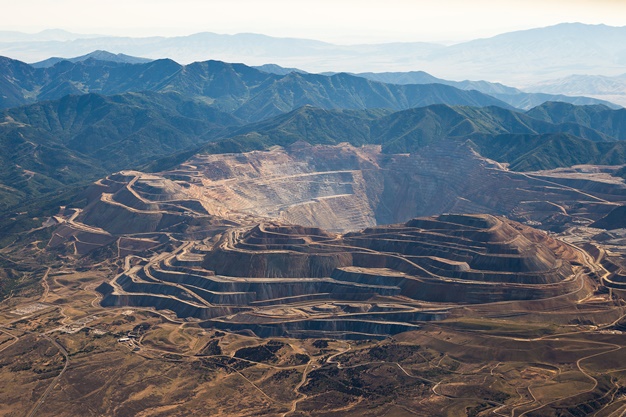
Full size / The Bingham Canyon Mine, an aerial photograph taken June 2018. (Source)

Full size / Bingham Canyon (left) as an exploration analogue for Core Assets‘ Blue Property (right). Note Bingham‘s lead-zinc-silver CRD mantos (yellow circles) in the south/west and north/east of the porphyry copper zone. Bingham‘s high-grade CRDs were mined long before Rio Tinto started mining the low-grade, bulk tonnage porphyry in 1903.
The Bingham Canyon Mine, also known as the Kennecott Mine, is located near Salt Lake City and is operated through Rio Tinto‘s subsidiary Kennecott Utah Copper. The Kennecott Mine, Copperton Concentrator and Garfield Smelter comprise one of the largest and most up-to-date integrated copper operations in the world, according to Mining Technology (July 2022). “Production from the mine stood at 159,400t of copper, 139,500oz of gold, 7,600t of molybdenum, and 2.22 million ounces (Moz) of silver in 2021... The Kennecott copper mine currently has a workforce of more than 2,000 workers.“
Proven & Probable Reserves (2021):
541 million t @ 0.44% copper, 0.17 g/t gold, 2.22 g/t silver, and 0.029% molybdenum, containing:
• 2.11 million t copper (in-situe value: $19 billion USD)
• 2.09 million ounces gold (in-situe value: $4.1 billion USD)
• 28.52 million ounces silver (in-situe value: $0.7 billion USD)
• 89,000 t molybdenum (in-situe value: $6.6 billion USD)
At today‘s market prices, the molybdenum reserves are the second-most valuable metal in the ground after copper. According to Mining Technology (July 2022): “Molybdenum was regarded as a minor contributor to income at the Kennecott Copper Mine, but increased world demand for molybdenum made it very important. Income from moly sales was just $30m in 2002 but rose to $700m in 2005. The 2008 mine plan was modified to include areas of higher moly content, even at the expense of copper... A major molybdenum deposit was discovered in 2008. Additional porphyry mineralisation was identified beneath the southern wall of the pit.“
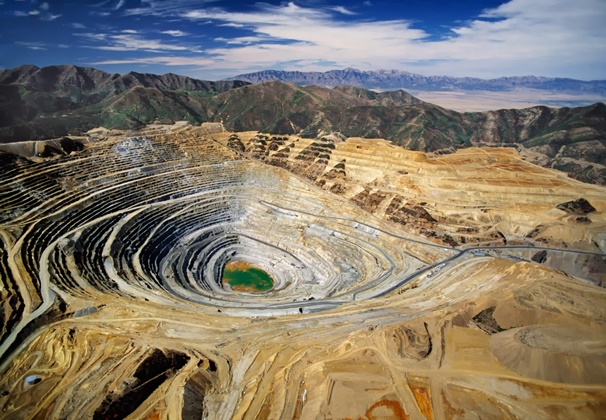
Full size / “The molybdenum grade of the ore mined from the Bingham Canyon porphyry Cu-Mo-Au deposit has historically been about 0.05% Mo. Recent drilling has provided a clearer picture of the distribution of molybdenum at depth. An inverted-cup shaped zone, or “shell”, of >0.09% Mo mineralization is present. The molybdenum shell overlapped part of the >0.35% Cu shell within the portion of the deposit that has already been mined.“ (Source / Image)
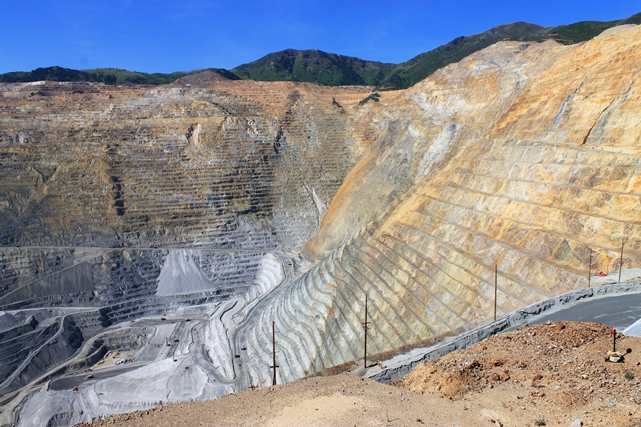
Full size / “Because the pit has mined the top of the inverted-cup shaped shell, the remaining molybdenum-rich zone takes the form of a thin walled annular cylinder. Based on blast hole sampling, the >0.09% Mo zone is a maximum of 200 meters in width. At its outer edge molybdenum grade decreases abruptly from 0.2% to less than 0.05% Mo over a distance of about 35 meters. The conditions under which molybdenite precipitated are not yet well understood but the remarkably sharp outer boundary of the higher-grade molybdenum mineralization suggests that the molybdenum may have been transported by a plume of buoyant fluid that was ascending rapidly through significantly cooler fluids. That plume appears to have had a diameter of approximately 1.8 km, and been generally coincident with the boundaries of the composite Bingham Stock.“ (Source / Image)
In September 2022, Rio Tinto approved a $55 million USD investment to start underground mining in 2023, initially focussing on an area known as the Lower Commercial Skarn (LCS) with a Resource of 7.5 million t @ 1.9% copper, 0.84 g/t gold, 11.26 g/t silver, and 0.015% molybdenum and a Probable Reserve of 1.7 million t @ 1.9% copper, 0.71 g/t gold, 10.07 g/t silver, and 0.044% molybdenum.
In September 2009, Rio Tinto announced this “massive molybdenum discovery beneath the floor of the open pit mine that could rival Colorado’s Climax and Henderson, two of the world’s biggest molybdenum deposits. The find is extraordinary because Bingham Canyon has been operating for more than a century and, while the main deposit still has legs, no one would have predicted that the world’s next big metal discovery would occur in such a mature environment. The other fascinating aspect of the news is that the discovery was actually made in 1970, but only became clear when Kennecott Utah Copper, a wholly-owned subsidiary of Rio Tinto, applied modern data processing and visualization techniques to historical drill logs... By 2004, molybdenum was becoming increasingly sought after for its ability to enhance the hardness, toughness, and corrosion resistance of metal alloys, particularly stainless steel. The price had increased 8-fold since the early 2000s to more than US$40 per pound and, as a result, Kennecott decided to revisit old drill logs that recorded molybdenum as part of a brownfields exploration program at Bingham Canyon.“
Today, the molybdenum price trades at $74 USD per kg ($34 USD per pound), down from $96 USD/kg in early March.
“The fresh rendering of the old drill data inspired the mine exploration team to launch a drill campaign below the floor of the pit, which is already more than kilometre deep and getting deeper everyday. Sixteen holes intersected high-grade molybdenum mineralization within a steeply dipping arcuate body that extends at least 1,000 metres below the pit floor. Based on the drilling so far, the deposit is estimated to contain in the order of 500-600 million tonnes grading 0.1-0.15% molybdenum. Hosted mainly by monzonite and occurring as quart-molybdenite veinlets and as molybdenite disseminations and fracture fillings, the mineralization remains open... Bingham Canyon, though primarily a copper deposit, has always been a significant gold and molybdenum producer... Bingahm Canyon is a classic copper porphyry with a fairly uniform distribution of sulphide mineralisation, mainly chalcopyrite. The existing pit will be worked out by 2019 but Kennecott is evaluating the feasibility of deepening the pit to add an extra 2.83 million tonnes of copper resources and extend the mine’s life from 2019 to 2036. The new discovery is considered a high-grade extension of the rich molybdenum zones with the main deposit. While the average grade of the molybdenum in the open pit reserve is 0.044% Mo, the grade within the new exploration target is up to 3.5 times richer. The mineralization appears to wrap around the barren core of the porphyry copper deposit in the northeast and southeast sectors of the deposit... Locally, the molybdenum mineralization reaches the surface on the eastern side of the pit bottom, where it has contributed to higher than average molybdenum head grades from 2004-2007. Batch flotation testing of composite samples indicated molybdenum recoveries of about 95% in rougher flotation... Companies never know what they might find when they pull out their dusty core logs and map sheets and start digitizing and visualizing the data in 3D. The Bingham Canyon molybdenum deposit may be the first major deposit to be found that way, but it is unlikely to be the last.“ (Source: “Discovery at the Bingham Canyon Mine“, 2009)
According to “Vectors to porphyry Cu-Au mineralization in carbonate wallrocks around the Bingham deposit“ (2021): “The Bingham Canyon porphyry Cu-Mo-Au occurrence (Utah, USA) is a highly productive mineral system with an extensive hydrothermal alteration halo. Such systems likely cause subtle, far-field alteration patterns which may be useful in vectoring toward the system center. This study presents initial results from our investigation into the effects of this hydrothermal system on two laterally extensive carbonate units, the Jordan and Commercial limestones... Bingham Canyon comprises a multi-phase sequence of Eocene-aged igneous rocks emplaced within a folded and thrusted Paleozoic carbonate and siliciclastic sequence, producing proximal Cu-Mo-Au porphyry-style mineralization and adjacent Cu-Au skarn deposits in carbonate host rocks, mainly in the Jordan and Commercial beds. Outboard from the porphyry-skarn zones (~0.5-2.5km) there are Pb-Zn-Ag vein and carbonate replacement orebodies, and even more distal (~7-9km) sediment-hosted Au deposits... Preliminary analysis reveals a decreasing trend in Fe, Mg, Ba, and several REEs from the Bingham Mine outboard to a distance of ~3-5km, while Mn and Zn display an increase to about 2km distance before dropping off to background levels ~4km outboard.“
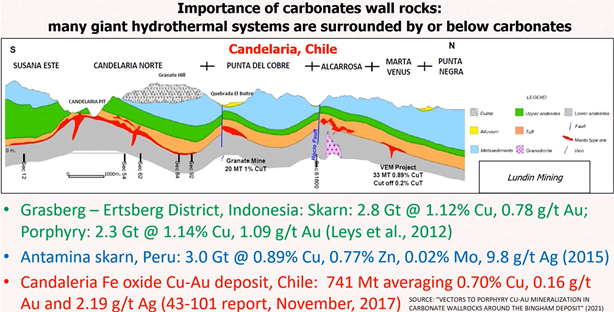
Full size / “Many world-class ore deposits are hosted within giant hydrothermal systems containing significant proportions of carbonate rock. Examples include the Grasberg-Ertsberg District in Indonesia, where the endowment of the ore is roughly split between skarns develoed in carbonates and disseminated porphyry-style mineralization. On the other end of the spectrum is Peru‘s Antamina Mine, where metals are predominately concentrated in the skarns.“ (Source)
“One other thing to take away ... very seldom only one manto. Sort of two end-members for these, one of which I call the Skeletal Hand Model because you end up with a wrist (in this case with...) a porphyry system but with a series of parallel mantos showing a district-wide zonation [fingers]... The other end-member is what I call the Hub & Spoke Model and Bingham Canyon demonstrates that beautifully. Everybody knows Bingham Canyon... It‘s one of the world‘s best porphyry copper mines. But people don‘t necessarily remember, or maybe never knew, is that Bingham is completely surrounded by high-grade lead-zinc-silver-copper carbonate replacement and skarn mineralization. A lot of these bodies were mined 60 years before they even started thinking about mining the porphyry.“ (Source)
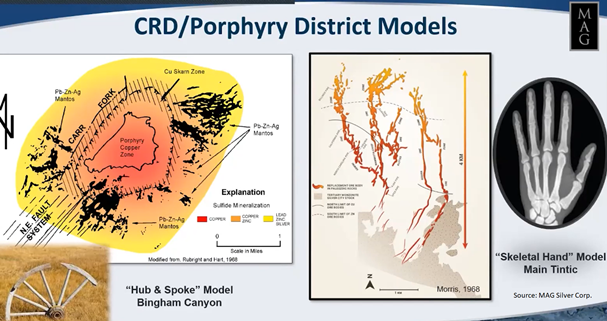
Full size / “The mineral deposits of the Tintic district [in Utah] are scattered across an astonishing 80 square miles of the East Tintic Mountains. The four combined Tintic subdistricts constitute the second largest metal producing district in the state (nearly 20 million tons of ore) with Bingham as the largest producer and Park City a close third. Historic production from the Tintic district has been largely derived from precious metal-rich, polymetallic chimneys and irregular, gently plunging rod-shaped replacement deposits... These deposits have also been called carbonate replacement deposits (CRD) and mantos.“ (Source)
Dr. Peter Megaw is the co-founder of Minera Cascabel and MAG Silver. His Ph.D. work was an exploration-focused geological study of the Santa Eulalia Ag-Pb-Zn District in Mexico and CRDs in general. He has published extensively on CRDs in both geological and mineralogical journals and books. Dr. Megaw and his team are credited with the significant discoveries at Platosa, Durango (Excellon Resources), Juanicipio-Fresnillo, Zacatecas (JV between Fresnillo and MAG Silver), Pozo-Seco/Cinco de May (MAG Silver).
“The Santa Eulalia Mining District is the largest of a number of important Ag-Pb-Zn-Cu-Au Carbonate Replacement Deposits that occur along the intersection of the Laramide-aged Mexican Thrust Belt and the Tertiary volcanic plateau of the Sierra Madre Occidental. Santa Eulalia and comparable districts form a spectrum ranging from stock contact skarns, through dike and sill contact skarns, and massive sulfides, to massive sulfide chimneys and mantos. The entire spectrum may be manifested on a district scale in highly elongated systems, or a significant portion of the spectrum may be displayed by single orebodies in highly telescoped systems. Santa Eulalia is a highly elongated system in which the distal (mantos to dike and sill contact skarns) parts of the spectrum have been encountered and exploited. The proximal, stock-related portions of the spectrum have never been found...“ (Source)
About CRDs
CRDs offer much larger tonnage potential than VMS and MVT deposits while at the same time typically hosting higher grades of silver, zinc, lead, and copper, sometimes with appreciable credits of gold and other metals.
CRDs are responsible for roughly 40% of Mexico’s 10 billion ounce historic silver production and are characterized by massive to semi-massive silver-lead-zinc-sulphide replacements of limestone. CRDs occur along major regional structures that hosts several of the largest CRDs in Mexico: “The Carbonate Replacement Deposit (CRD) model evolved from Dr. Peter Megaw’s PhD studies at Santa Eulalia: repeatedly validated worldwide...The Santa Eulalia District ranks as one of Mexico’s chief silver and base metal producers, and its largest CRD. Historic district production (1703-2020) amounts to 51 Mt of ore at average grades of 310 g/t Ag, 8.2% Pb, 7.1% Zn, yielding a total of 500 Moz Ag, 4 Mt Pb and 3.6 Mt Zn.“ (Source)
“CRDs are the second largest contributor to the historic silver production of Mexico. CRDs are the backbone of Mexico’s world-class underground lead-zinc mining industry. The country contains many Ag-Pb-Zn (Cu, Au) CRDs, which occur along the intersection of the Mexican Thrust Belt and Sierra Madre Occidental Magmatic Belt. The biggest CRD deposits appear to lie along inferred deep crustal structures.“ (Source)
While VMS deposits oftentimes host metallurgically complex ores, CRDs and MVTs are rather uncomplicated metallurgically. The total average operating costs (for mining, milling and processing) are generally lower for CRDs and MVTs than for VMS and Sedex-type deposits or even vein-type deposits. (Source) Moreover, CRDs typically form as a result of a near-by porphyry intrusion, thus offering potential to add large tonnage from mining such deposit aside from CRDs. These days, most of such projects worldwide are facing the challenge of many companies controlling small portions of a CRD-porphyry system, oftentimes under option agreements and/or with underlying royalty liabilities (NSRs; Net Smelter Royalties; somewhat unattractive for majors). This makes it difficult for majors to acquire the full extent of such large CRD-porphyry systems to better understand the regional geology and structure of the complex with district-scale exploration programs. With Blue, Core Assets owns 100% of a very large, district-scale property (1083 km2), royalty-free. Once the geology and structure of the CRD showings at surface are better delineated with drilling, this potential CRD mineralization (chimneys, mantos, and/or skarns) is targeted to lead to the source – possibly a large and well-mineralized copper porphyry enriched with gold or molybdenum.
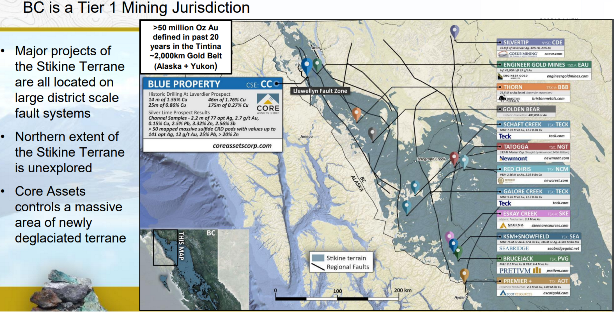
Full size / Source: Core Assets Corp.
Despite over 130 million ounces of gold, 800 million ounces of silver and 40 billion pounds of copper already found in Golden Triangle‘s rugged terrain, significant discovery potential remains. With glaciers retreating in many parts of the region, new geological explanations and modern exploration methods are paving the way for new discoveries in the making.
Bull market in base and precious metals
Previous Coverage
Report #9: “Core Assets drills ultra-high-grade silver, zinc and lead at Silver Lime: 3,019 g⁄t silver equivalent at Grizzly and 982 g⁄t silver equivalent at Jackie“ (Web Version / PDF)
Report #8: “Drills are turning at Laverdiere (the find of the 1970s) followed by Silver Lime (the find of the 2020s?)“ (Web Version / PDF)
Report #7: “With a portable core drill, Nick tested some discovery outcrops“ (Web Version / PDF)
Report #6: “Exceeding expectations with high grades of silver, copper, zinc, lead, and gold from sampling at the Blue Property in northern British Columbia“ (Web Version / PDF)
Report #5: “Retreating ice uncovers major discovery potential for CRD-Porphyry system at district-scale Blue Property, BC“ (Web Version / PDF)
Report #4: “The Silver-Copper Super-Cycle“ (Web Version / PDF)
Report 3: “The Llewelyn Fault Zone: A district-scale plumbing system analog to other prolific mining and exploration camps in the Golden Triangle?“ (Web Version / PDF)
Report 2: “On a Mission to Become the Premier Copper-Gold Porphyry Explorer of the Northernmost Extent of the Golden Triangle“ (Web Version / PDF)
Report 1: “Perfect Time to Reshape the Golden Triangle in British Columbia“ (Web Version / PDF)
Company Details

Core Assets Corp.
Suite 1450 – 789 West Pender Street
Vancouver, BC, V6C 1H2 Canada
Phone: +1 604 681 1568
Email: info@coreassetscorp.com
www.coreassetscorp.com
Incorporation Date: April 20, 2016
Listing Date: July 27, 2020
CUSIP: 21871U05 / ISIN: CA21871U1057
Shares Issued & Outstanding: 84,789,432
Canadian Symbol (CSE): CC
Current Price: $0.25 CAD (03/28/2023)
Market Capitalization: $21 Million CAD
German Symbol / WKN: 5RJ / A2QCCU
Current Price: €0.158 (03/28/2023)
Market Capitalization: €13 Million EUR
Contact:
www.rockstone-research.com
Core Assets News-Disclaimer: Neither the Canadian Securities Exchange nor its Regulation Services Provider (as that term is defined in the policies of the CSE) accepts responsibility for the adequacy or accuracy of this release. FORWARD LOOKING STATEMENTS: Statements in this document which are not purely historical are forward-looking statements, including any statements regarding beliefs, plans, expectations, or intentions regarding the future. Forward looking statements in this news release include, but are not limited to, expectations regarding the pending core assays, including speculative inferences about potential copper, molybdenum, gold, silver, zinc, and lead grades based on preliminary visual observations from results of diamond drilling at the Silver Lime Project and the Laverdiere Project, as applicable; the Company’s plans to further investigate the geometry and extent of the skarn and carbonate replacement type mineralization continuum at the Silver Lime Project through additional field work and diamond drilling and any planned or proposed program related thereto; and any other general statement regarding the Company’s planned or future exploration efforts at the Blue Property. It is important to note that the Company’s actual business outcomes and exploration results could differ materially from those in such forward-looking statements. Risks and uncertainties include that expectations regarding pending core assays based on preliminary visual observations from diamond drilling results at the Silver Lime Project and the Laverdiere Project, as applicable, may be found to be inaccurate; that results may indicate further exploration efforts at the Silver Lime Project and the Laverdiere Project, as applicable, as not warranted; that the Company may be unable to implement its plans to further explore at the Silver Lime Project and the Laverdiere Project, as applicable; that certain exploration methods, including the Company’s proposed exploration model for the Blue Property, may be ineffective or inadequate in the circumstances; that economic, competitive, governmental, geopolitical, environmental and technological factors may affect the Company’s operations, markets, products and prices; our specific plans and timing drilling, field work and other plans may change; that the Company may not have access to or be able to develop any minerals because of cost factors, type of terrain, or availability of equipment and technology; and we may also not raise sufficient funds to carry out or complete our plans. The ongoing COVID-19 pandemic, labour shortages, inflationary pressures, rising interest rates, the global financial climate and the conflict in Ukraine and surrounding regions are some additional factors that are affecting current economic conditions and increasing economic uncertainty, which may impact the Company’s operating performance, financial position, and future prospects. Collectively, the potential impacts of this economic environment pose risks that are currently indescribable and immeasurable. No assurance can be given that any of the events anticipated by the forward-looking statements will occur or, if they do occur, what benefits the Company will obtain from them. Readers are cautioned that forward-looking statements are not guarantees of future performance or events and, accordingly, are cautioned not to put undue reliance on forward-looking statements due to the inherent uncertainty of such statements. Additional risk factors are discussed in the section entitled “Risk Factors” in the Company’s Management Discussion and Analysis for its recently completed fiscal period, which is available under the Company’s SEDAR profile at www.sedar.com. Except as required by law, the Company will not update or revise these forward-looking statements after the date of this document or to revise them to reflect the occurrence of future unanticipated events.
Rockstone Disclaimer: This report contains forward-looking information or forward-looking statements (collectively "forward-looking information") within the meaning of applicable securities laws. Forward-looking information is typically identified by words such as: "believe", "expect", "anticipate", "intend", "estimate", "potentially" and similar expressions, or are those, which, by their nature, refer to future events. Rockstone Research, Core Assets Corp. and Zimtu Capital Corp. caution investors that any forward-looking information provided herein is not a guarantee of future results or performance, and that actual results may differ materially from those in forward-looking information as a result of various factors. The reader is referred to Core Assets Corp.´s public filings for a more complete discussion of such risk factors and their potential effects which may be accessed through its profile on SEDAR at www.sedar.com. Please read the full disclaimer within the full research report as a PDF (here) as fundamental risks and conflicts of interest exist. The author, Stephan Bogner, holds an equity position in Core Assets Corp., as well as in Zimtu Capital Corp., and is being paid by Zimtu Capital Corp. for the preparation, publication and distribution of this report, whereas Zimtu Capital Corp. also holds a long position in Core Assets Corp. Note that Core Assets Corp. pays Zimtu Capital Corp. to provide this report and other investor awareness services. Zimtu Capital Corp. is an insider of Core Assets Corp. by virtue of owning more than 10% of Core’s issued stock. Core Assets Corp. has one or more common directors with Zimtu Capital Corp. The cover picture (amended) has been obtained and licenced from Gluiki.




